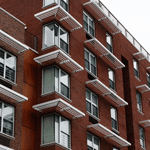If there’s one thing to know about New York’s OCV Architects, it’s that the firm specializes in affordable housing and that, because of this, its 22-member team knows how to work in, and out of a tight spot. Since the early 1980s, OCV has provided low-income housing solutions throughout New York City, and as sustainability continues to revolutionize design philosophy across the industry, OCV can be seen as a microcosm of that evolution, creating greener housing throughout the city’s five boroughs.
In 2005, OCV began work on Fox Point Terrace, a 54,400-square-foot, LEED Gold housing complex sponsored by Palladia Inc. and funded by the Homeless Housing Assistance Program, Homes and Community Renewal, and the Department of Housing Preservation and Development. The project’s 48 units are for formerly homeless and low-income families, but what’s unique about Fox Point is that those units include amenities most likely foreign to many of its residents.
Earning 70 percent of the possible points in LEED’s energy-optimization category, the units feature large, argon-filled, low-E windows and Energy Star appliances. The building as a whole—which includes various common areas and living units ranging from simple studios to three-bedroom apartments, all managed by a full-time support staff—has an incredibly efficient envelope and high-efficiency equipment throughout. It also uses a microturbine to generate power and heat that ultimately reduces facility dependence on utility power.
“When we began planning Fox Point, [we were] already implementing sustainable features in our projects, though the process hadn’t been formalized by outside certification,” says Mary Ellen Cooper, a project manager at OCV. “Palladia approached us after the schematic design and told us they wanted a LEED rating on the building. We were more than happy to take them up on that.”
The project was a first for the firm. “This . . . was the first project where we were responsible for all of the sourcing, documentation, and submittals necessary to achieve LEED status,” Cooper says. Which anyone can tell you is no small amount of work. The timeline of certification, too, can be arduous. Although Fox Point was completed in 2009, it was only awarded its LEED Gold designation in spring 2012.
A good architecture firm will do what’s asked of it; a great one will push projects into even greener territory. It was originally planned that Fox Point attain LEED Silver certification, but OCV saw that LEED Gold was feasible. The architects maximized open spaces and included two green rooftops and a vegetated yard, reducing urban heat island effect and decreasing storm-water runoff. “Controlling runoff is important from a municipal standpoint,” Cooper says. “[It] lessens the building’s impact on urban infrastructure systems.”

Fox Point’s community room, library, and computer room face the rear yard and play areas. The fenestration lets light into the spaces, and the operable windows let fresh air flow inside. The apartments have open kitchens, bamboo flooring, and low-VOC finishes.
Points were tallied for indoor environmental quality, thanks to low-VOC finishes and the controllability of individual systems. “Many of these individuals were homeless prior to arriving at Fox Point,” Cooper says, “so it was very meaningful for them to have control over their own environment.”
Richard Vitto, a principal at OCV, emphasizes the synergies of green building’s goals with affordable housing’s. “Fox Point is a building constructed with less environmental impact at the local and global level,” he says, “and it employs technologies and design techniques that greatly reduce operational costs while providing an aesthetically pleasing, comfortable, and healthy place to live.”
OCV sought similar synergies in its recent partnership with the Jericho Project—a New York-based living assistance organization—for the $14 million, 76-unit, 44,000-square-foot Kingsbridge Terrace Veterans Residence, which is targeting LEED Silver status. It’s the second veterans residence funded by the Jericho Project, strategically sited to be adjacent to the Bronx VA Medical Center.
“For this project, we are taking everything we learned from Fox Point and planning on a repeat success,” Cooper says. Again, OCV is overseeing the LEED certification of Kingsbridge, which will feature green roofs, energy-efficient HVAC systems, Energy Star appliances, and recycled, rapidly renewable, and reclaimed building materials, as well as a microturbine similar to Fox Point’s. The site’s configuration allows for natural lighting and surprisingly grand views.
Kingsbridge and Fox Point epitomize both OCV’s commitment to environmentally conscious design and a new, citywide standard for affordable housing that uses architecture and social services to assist residents while also giving back to the urban environment.


